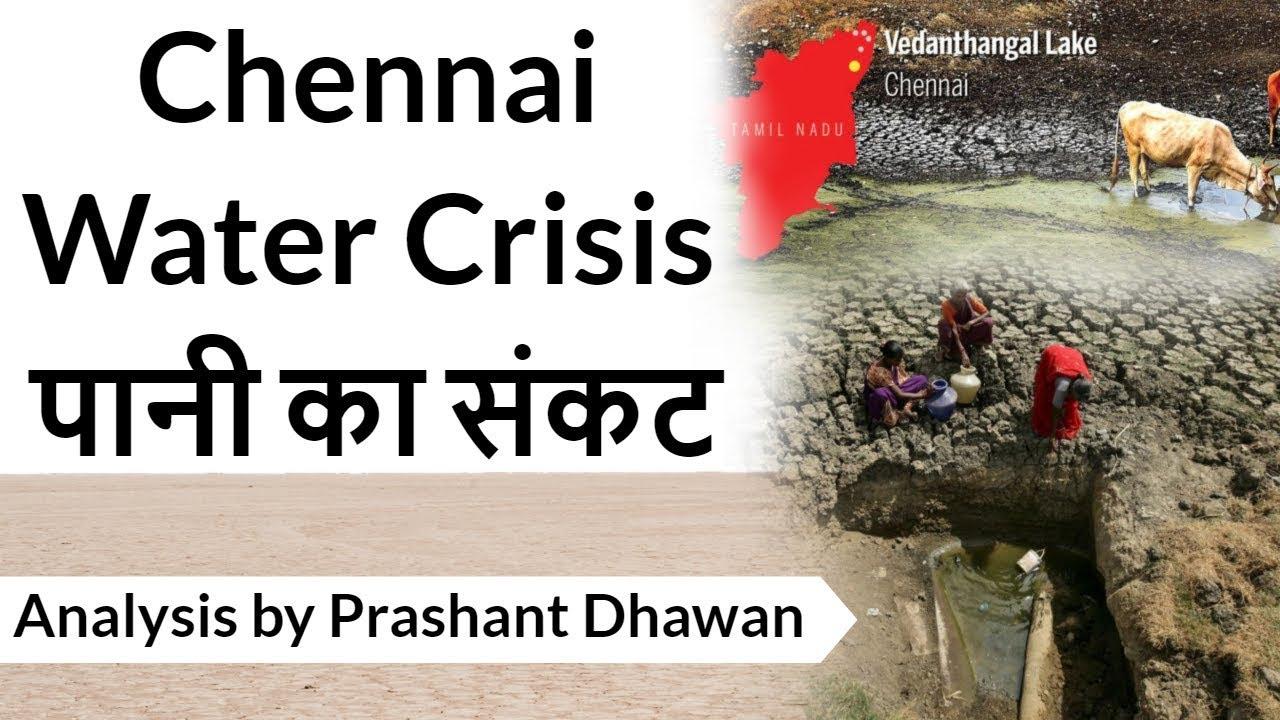Table of Contents
WATER CRISIS IN CHENNAI
- Around 2,000 years ago, in his immense and matchless wisdom, the sage-poet Thiruvalluvar said there was no world without water, Neer indri amaiyathu ulagu.

- After weeks of soaring temperatures and drought, Chennai, India—the country’s sixth largest city—is facing a dire water shortage. The four reservoirs that provide the majority of the city’s water supply have dried up, forcing restaurants, businesses, and schools to close and leaving residents to wait in line for hours for water from municipal or private tankers.
- The water crisis is hitting the region’s poor particularly hard; wealthy residents can pay the premiums for water from private tankers that those living in slums can’t afford.


BUT HOW DID CHENNAI LOSE ITS WATER?
- Three rivers – the Cooum, the Adyar, and the Kosasthalaiyar – flow through Chennai into the Bay of Bengal. The Buckingham canal connects all the three rivers. North Chennai gets its water from reservoirs in Thamaraipakkam and Minjur desalination plant. South Chennai gets its water from Veeranam lake and Nemmeli seawater desalination plant.

THE THREE RIVERS?
- Three ‘rivers’ crisscross the metropolis, but they have all been dead for years. Cooum was killed by filth and untreated sewer being let into it for decades. Buckingham Canal and Adyar too are no better. Today, they are glorified gutters as their feeder lines and banks have been ceded to encroachers small and big. Governments have sunk several thousand crores of rupees in ‘river restoration projects’ but little has been achieved
NUMBERS
- To put this issue in perspective, it’s important to consider the annual rainfall Chennai receives. Chennai receives an annual rainfall of 132.4 cm, which is more than the all-India average. The northeast monsoon (October-December) brings, on average, 60% of the annual rainfall. Last year, the northeast monsoon failed Chennai. The city received only 35.2 cm of rainfall, a deficit of 55%.

- About a year ago, the Comptroller and Auditor General (CAG) submitted a performance audit report of flood management efforts in Chennai. The audit also covered water storage efforts. The section of the CAG report which examined governments’ attempts to enhance the city’s water storage reached the following dismal conclusion:
- “Projects to restore and increase the storage capacities of the tanks and reservoirs suffered setbacks due to faulty planning and lack of co-ordination between various Government agencies.”
SAD STORY
- Chennai’s total water requirement is about 830 million litres a day. The government claims that it is now supplying about 530 million litres a day. The city receives water from four primary reservoirs: Puzhal, Chembarambakkam, Cholavaram and Poondi. All four are on the verge of going dry. CHEMBARAMBAKKAM RESERVOIR SHRINKING FROM JUNE 2018 TO JUNE 2019

NEED FOR WATER GOVERNANCE
- According to a recent NITI Aayog report, 21 Indian cities will run out of groundwater by 2020 if usage continues at the current rate. Water governance in cities across India has been ad hoc. Learning their lessons from the Chennai crisis, other metropolitan cities should now set up urban water planning and management boards, a permanent body similar to urban development authorities, that regulate the supply, demand and maintenance of water services and structures.
INDIA’S SITUATION
- Samrat Basak, the director of the World Resource Institute’s Urban Water Program in India Samrat Basak, the director of the World Resource Institute’s Urban Water Program in India As cities expand, they’ve displaced wetlands and lakes that previously captured water and funneled it underground to recharge aquifers. Restoring and conserving urban water bodies could help cities in India prepare for future water shortages. Madras High Court, the high court in the state of Tamil Nadu, where Chennai is located, also criticized the state government for not taking more proactive actions to prevent the water crisis.

























 WhatsApp
WhatsApp